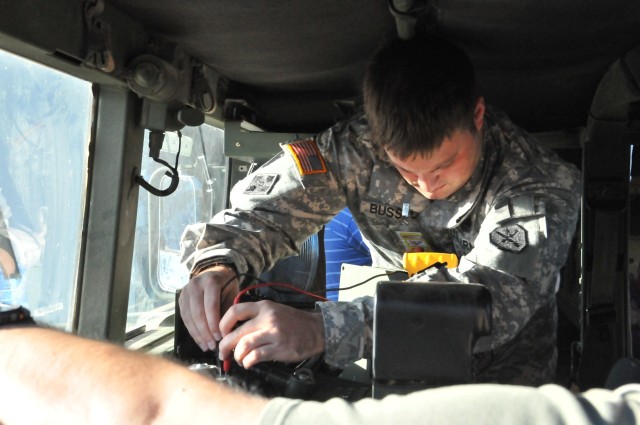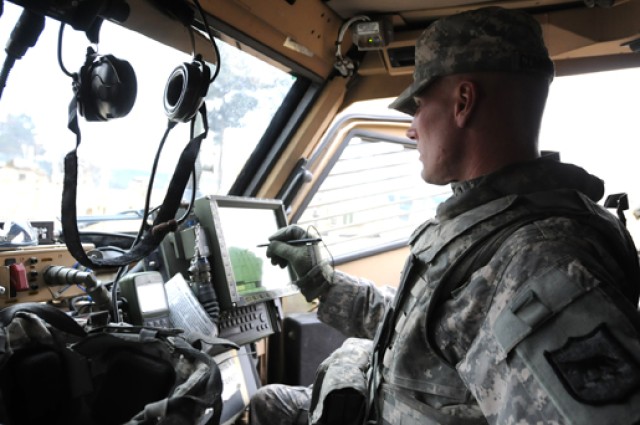With more than 100,000 systems in the field and a lifesaving track record in Afghanistan and Iraq, the Army's friendly force tracking and messaging software is preparing for the future with a new version that is faster, more versatile and better connected to the Marine Corps.
Next up: a tryout with Soldiers as part of the Army's unprecedented combined test and evaluation at White Sands Missile Range, N.M. in June.
The Limited User Test for the new version of Force XXI Battle Command Brigade-and-Below/Blue Force Tracking (FBCB2/BFT), called Joint Capabilities Release (JCR), will support a decision on wider fielding of the capability - which thus far has been fielded to several brigades inside the United States. The LUT also marks a step toward a broader plan to move to the next-generation FBCB2/BFT technology for tactical aircraft, vehicles and dismounted forces, called Joint Battle Command-Platform (JBC-P).
"JBC-P is a foundation for achieving information interoperability between Joint warfighting elements on current and future battlefields," said Gen. Peter Chiarelli, the Army's vice chief of staff, in recent testimony to the House Armed Services tactical and land forces subcommittee. "It will be the principal command and control system for the Army and Marine Corps at the brigade-and-below level, providing users access to the tactical information necessary to achieve information dominance on the battlefield."
JCR acts as a "bridge" to JBC-P, providing today's deployed units with Army-Marine Corps interoperability, a faster satellite network, advanced mapping kits, secure data encryption and integration with historical information key for counterinsurgency operations. At White Sands, which resembles the mountainous terrain of Afghanistan, Soldiers will run missions to test JCR's effectiveness and reliability for exchanging messages, providing situational awareness of fellow "blue" forces to guard against fratricide, navigating the battlefield and other capabilities.
JCR is one of several programs of record undergoing simultaneous testing with the 2nd Brigade, 1st Armored Division during the six-week event, known as the Network Integration Evaluation (NIE). Several other systems that are not part of the formal tests are also participating, including applications that provide Warfighters with fires planning, protection from rocket and mortar attacks and efficient energy sources.
The evaluation will culminate with an integration exercise demonstrating how the systems fit into the Army's tactical network connecting Soldiers at all echelons. The information will travel throughout the brigade over the terrestrial network provided by the Joint Tactical Radio System (JTRS) and the satellite communications backbone provided by the Warfighter Information Network - Tactical (WIN-T).
The June NIE is the first of a series of four events leading to executing a fully integrated Brigade Combat Team Network Evaluation at the end of 2012. This approach will allow the Army to evaluate programs of record and new ideas from industry more quickly, integrate them prior to fielding to units in combat and make incremental improvements based upon feedback, officials said.
Soldiers at White Sands will use a rugged handheld known as the Pocket-Sized Forward Entry Device (PFED), which allows forward observers to send a digital call-for-fire within 10 seconds.
Soldiers will be supported by more efficient energy sources, including an intelligent power system that adjusts distribution based on need, and a hybrid energy system consisting of a lightweight tripod with a pair of 50-watt rigid-panel solar arrays, batteries and a military generator.
At brigade headquarters, the BCT commander and his staff will view a real-time, integrated air picture and receive warnings of incoming rocket, artillery and mortar attacks. Live and simulated feeds will create a realistic, comprehensive scenario to demonstrate and evaluate Counter-Rocket, Artillery, and Mortar (C-RAM) Indirect Fire Protection Capability (IFPC).
Commanders inside the tactical operations center will use Command Post of the Future (CPOF), which enables them to share map displays, charts and other data. CPOF is the foundation of the Battle Command Workstation, a central piece of the ongoing "collapse strategy" seeking to consolidate BC systems.
Also being integrated into the Army's network is Tactical Ground Reporting (TIGR), a collaborative software tool that uses a "Google Earth"-like interface, pictures and text to provide a searchable database of unit activities. Along with routes and places, TIGR is valuable for tracking people - such as local police chiefs, religious leaders or other key figures for counterinsurgency and stability operations. Such information is known as ASCOPE data, for Area, Structures, Capabilities, Organizations, People, and Events. TIGR, developed by the Defense Advanced Research Projects Agency (DARPA), is scheduled to formally transition to Project Manager FBCB2 management on Oct. 1.
In JCR, users can toggle between TIGR and FBCB2 windows. In JBC-P, ASCOPE functionality similar to TIGR will display on a single user-friendly screen inside the tactical vehicle.
"Where we are going with JBC-P on the platform is to develop a user interface that is similar to things that are normally done in gaming, in Facebook, Twitter," said Col. Buddy Carman, Training and Doctrine Command (TRADOC) Capability Manager for BCT Mission Command. "The more we can make (functions) translatable, Soldiers are going to use it more often and we're going to eliminate a huge training burden on them."
Feedback from the JCR LUT will influence JBC-P design and capabilities, as well as inform a JCR fielding decision for the fiscal year starting in October 2011, said Robert Cohen, support contractor for PM FBCB2. JCR began fielding to operational units in January, with nearly 1,400 sets of the software deployed through March, officials said.
Claire Heininger, Symbolic Systems, Inc., is a contractor supporting the Army's Program Executive Office Command, Control and Communications - Tactical (PEO C3T).
Related Links:
Army demonstrating wideband waveforms
Preparations underway as Army gears up for large-scale network evaluations




Social Sharing